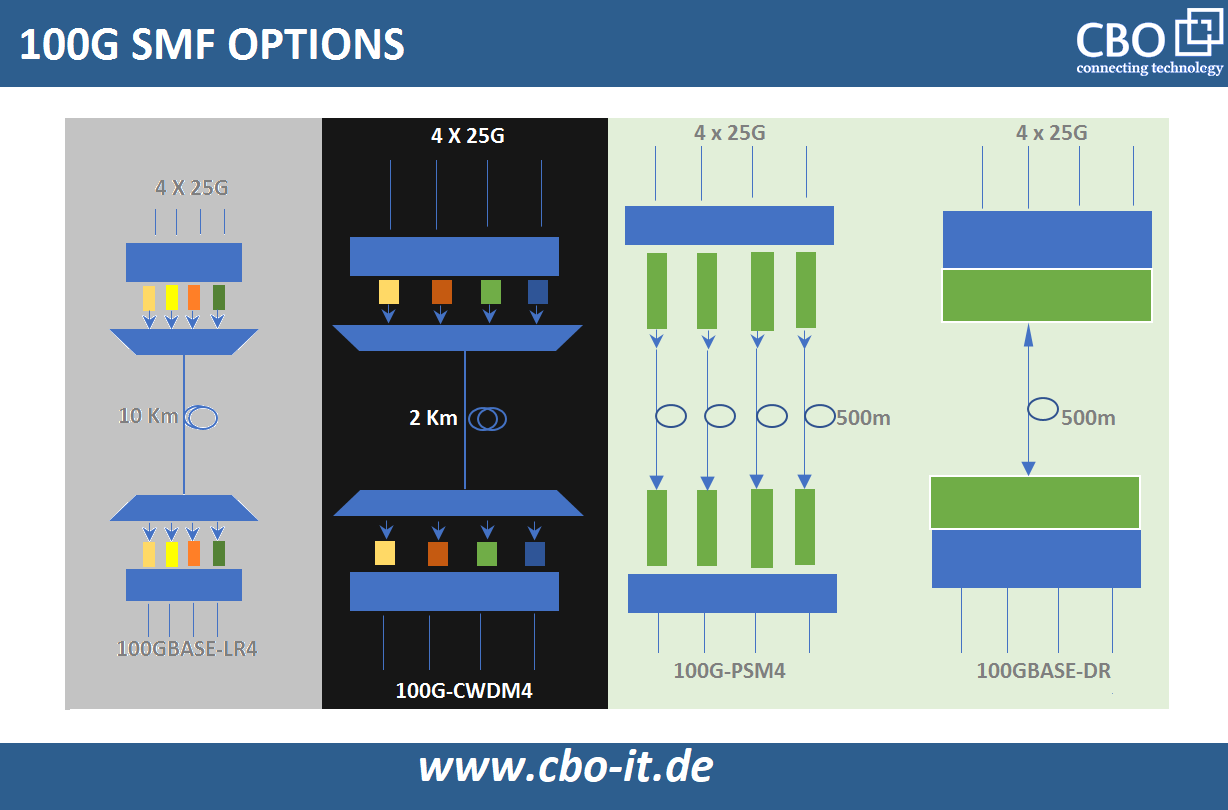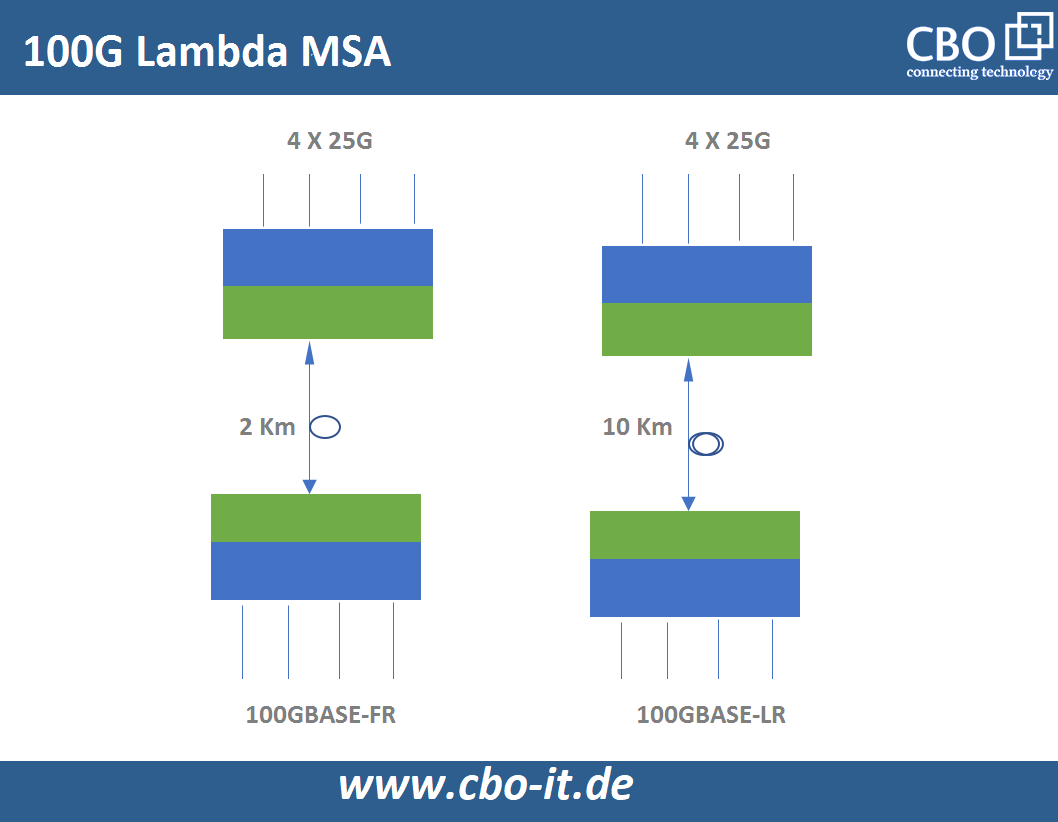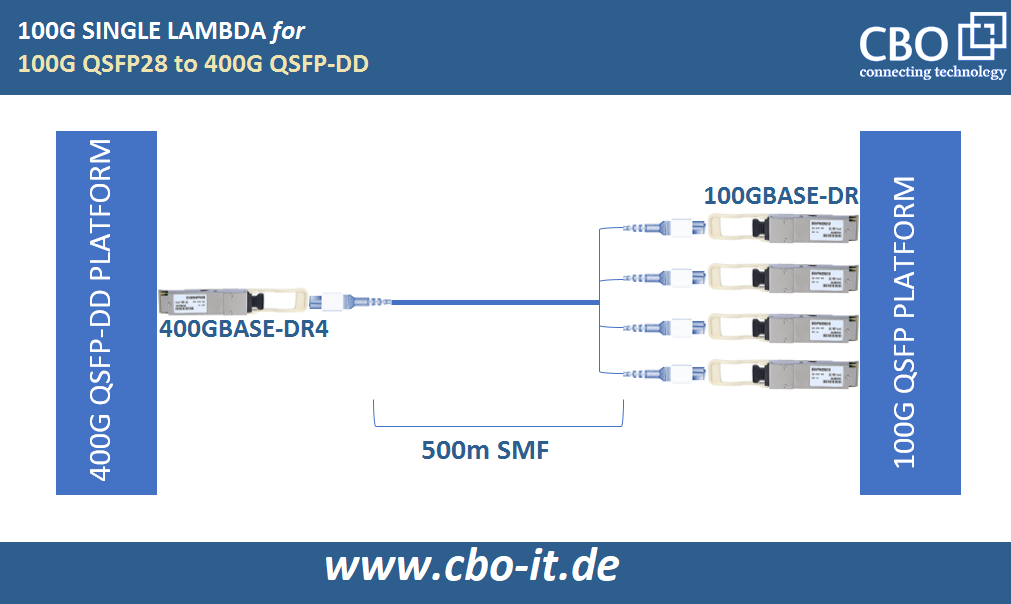100G single lambda is a widely used optical specification based on PAM4 signaling. 100G single lambda is commonly used for transmission of 100G data streams over a single wavelength or laser. 100G Lambda MSA governs the development of this specification and it is designed for use in 400G and 100G applications.
The occurrence of 100G single lambda is not uncommon as various optical transceivers such as 100GBASE-SR4, 100GBASE-LR4, 100G-CWDM4 and 100G-PSM4 are equipped with four sets of receivers and transceivers to operate within 25Gb/s parallel lanes. These four optical signals are either optically multiplexed or coupled via parallel fibers to a single fiber for data transmission. This arrangement cannot be implemented without the use of expensive optical components. On the other hand, 100G lambda is a cost-effective solution that results in higher transmission efficiency at lower cost. Transceivers that meet this specification use 100G PAM4 signaling technology for 100G transmission per wavelength - an arrangement that reduces overall cost and optical complexity by reducing the number of optical receivers and transmitters from four to one.

100GBASE-LR4 is proposed for up to 10km stretched links consisting of 4 multiplexed wavelengths carried by a single fiber. However, closely spaced wavelengths with LAN WDM wavelength spacing cannot be accommodated without expensive hermetic packaging for optimal laser temperature control.
Let us now proceed to the second option, i.e. 100GBASE-CWDM4. This option is better in terms of wavelength spacing, but no connections over 2km are possible with this configuration. Here comes the third option, i.e. 100GBASE-PSM4. This option uses 4 fiber pairs and a wide wavelength for data transmission and thus can resolve the complexity associated with lasers with multiple wavelengths. 100GBASE-PSM4 is a good option, but can only be considered for links up to 500m.
100G Single Lambda Vs. 100G QSFP28 - a comparison
According to one estimate, about 60% of the total cost of a 100GE pluggable optical module is its optical components. Common 100G QSFP28 modules available on the market (e.g. 100GBASE-SR4) come with discrete optical components to achieve 25 Gbps per lane. It is the number of discrete components that determines the final price of an optical transceiver. A transceiver with fewer discrete components will cost less than one with a larger number of discrete components.

Let's now bring 100G single lambda into the discussion. The three transceivers included in the 100G single lambda series are 100GBASE-LR (100G-LR), 100GBASE-FR (100G-FR), and 100GBASE-DR. These transceivers are designed to receive an electrical signal from the host (in a 4 x 25G configuration) and have a DSP that converts the received signals using PAM4 modulation, as opposed to PSM4, LR4 or CWDM4 where NRZ signals are used. The application of PAM4 signals on a single wavelength means that a single laser can be used to transmit the full 100G data stream. This network infrastructure eliminates the need for parallel fiber or WDM, resulting in a reduction in the number of optical components required, such as receivers and transmitters. The 100GBASE-DR supports links up to 500m, while the 100GBASE-FR and 100GBASE-LR are available for 2km and 10km, respectively.
Considering the above facts, it could be found that the latest version of 100G single lambda not only provides cheaper 100G links, but also reduces the complications of optical components. According to IEEE experts, transmitting 100GE optical signals over a single optical lane can result in deployment cost savings of up to 40%. That is, moving from four wavelengths to one wavelength can result in a cost reduction of more than 40%.
100G single lambda in 400G networks
As Internet traffic grows, the need for low-cost and simple pluggable optical modules becomes a necessity for transceiver development, especially for high-density, high-speed applications such as 200 and 400G. 100G Lambda can ease the transition from 100 to 400G by reducing the structural complexity of 400G modules. At the same time, it will also bring great savings by reducing the number of fibers.

100G Single Lambda for 100G QSFP28 to 400G QSFP-DD upgrade
The 100G Lambda MSA group has also contributed to the upgrade of the existing 400G IEEE standards. In the existing standards, 400G optical transceivers are based on 8 x 50G PAM4 lanes. This high number of wavelengths and the complexity of demultiplexer and multiplexer appear impractical and costly in various network environments. To address these challenges, the 100G Lambda MSA group came up with the idea of using 100G per wavelength in 400G links - an arrangement that requires four channels on the CWDM wavelength grid instead of eight. This created a more cost-effective path to 400G upgrading.
Conclusion:
- 100G Single Lambda is a cost-effective solution for building 100G connections
- The three transceivers used in setting up 100G single lambda links are 100GBASE-FR, 100GBASE-DR and 100GBASE-LR.
- Using a single wavelength for 100G transmission saves up to 40% in costs
 English
English
 Deutsch
Deutsch
 Espaniol
Espaniol










